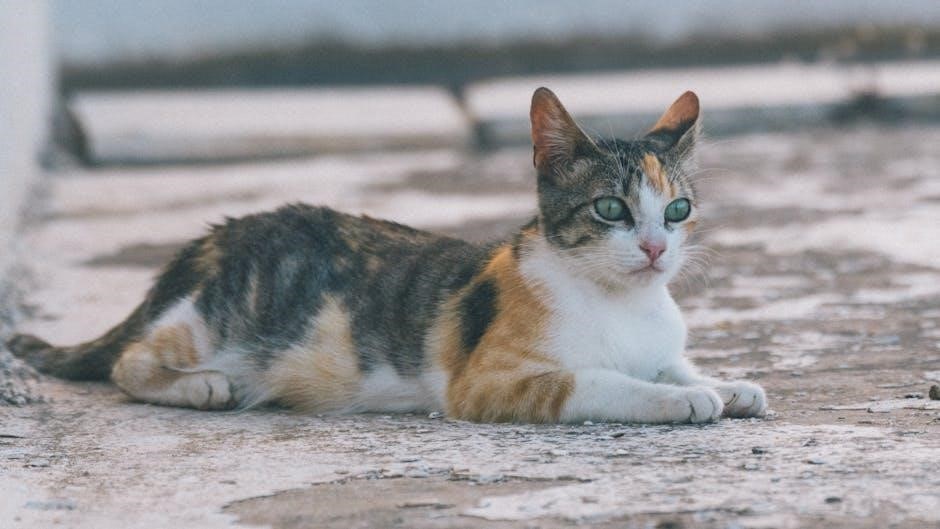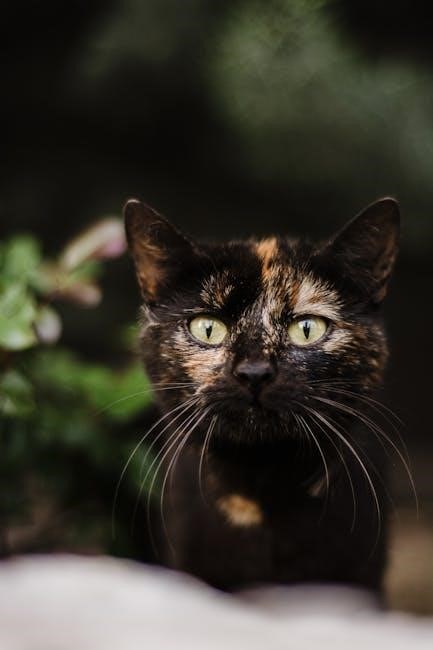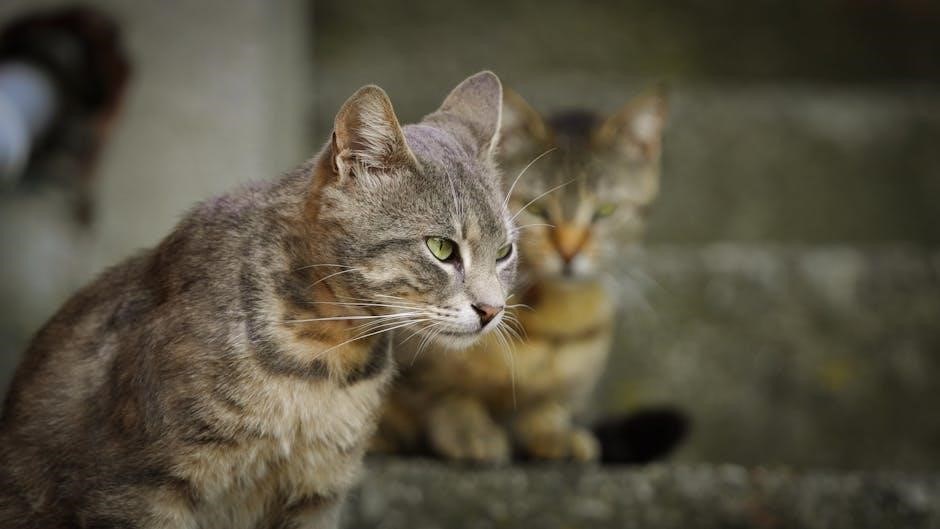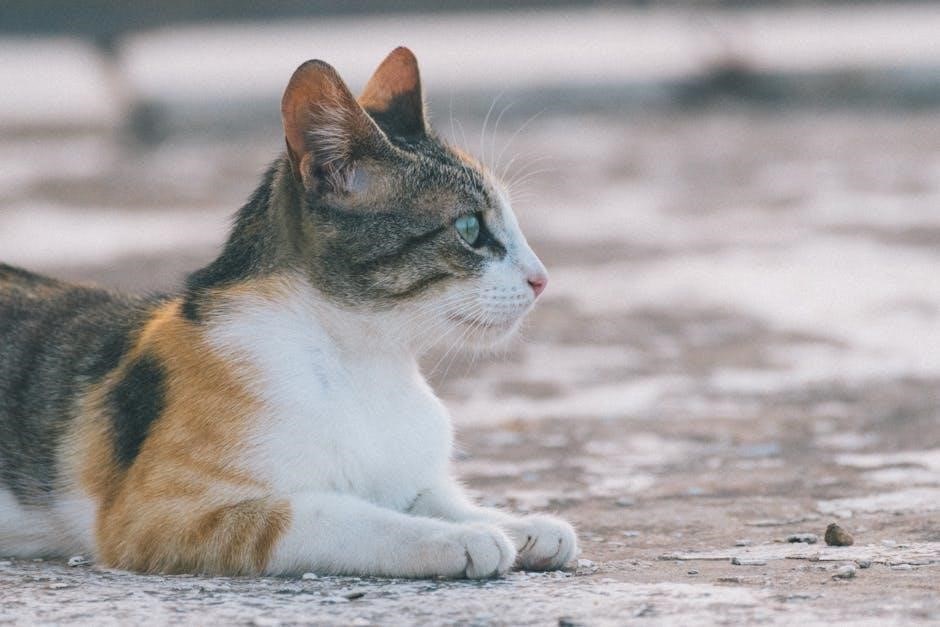
filetype:pdf cat
Cats, beloved as pets worldwide, exhibit unique behaviors and health needs. Their domestication has led to diverse breeds, each with distinct characteristics, making them fascinating companions for many.
1.1 Overview of Domestic Cats (Felis catus)
Domestic cats, scientifically known as Felis catus, are one of the most popular household pets worldwide. With over 10.8 million owned cats in the UK alone, they are beloved for their independence and affectionate nature. Domestic cats are known for their grooming habits, playful behavior, and ability to form strong bonds with humans. However, they also carry responsibilities, such as the need for regular veterinary care and vaccination. Outdoor cats, in particular, can pose risks to wildlife and may transmit diseases like toxoplasmosis. Understanding their behavior, health needs, and proper care is essential for ensuring their well-being and the safety of their environment.
1.2 Historical Significance of Cats as Pets
Cats have been human companions for thousands of years, with evidence of domestication dating back to ancient civilizations. In Egypt, cats were revered as sacred animals, associated with the goddess Bastet, and often mummified and buried with their owners. Their ability to hunt pests made them invaluable, leading to their spread across Europe and beyond. Historical records show cats were not only working animals but also symbols of wealth and status. Over time, their role evolved from utility to beloved pets, with selective breeding leading to diverse breeds. This rich history highlights their unique bond with humans, shaped by mutual benefits and affection, making them a cornerstone of many cultures worldwide.
1.3 Importance of Cat Behavior and Health
Understanding cat behavior and health is crucial for their well-being. Cats exhibit unique communication methods, such as vocalizations and body language, which are vital for social interactions. Health issues like feline leukemia and dental problems significantly impact their quality of life. Regular veterinary care, including vaccinations and microchipping, ensures their longevity. Behavioral traits, such as hunting instincts, highlight their natural predatory nature, while mental well-being depends on environmental enrichment. Owners play a pivotal role in maintaining their cats’ physical and emotional health, making education on proper care essential. By addressing these aspects, cat owners can provide a nurturing environment that supports their pets’ overall health and happiness.

Cat Behavior and Psychology
Cats are intelligent, curious creatures with unique problem-solving abilities. Their behavior often reflects instinctual traits, such as hunting, while their psychology shows adaptability to environmental and social interactions.
2.1 Communication Methods in Cats
Cats communicate through vocalizations, body language, and scent marking. Vocalizations include meows, purrs, hisses, and growls, each serving specific purposes like seeking attention or signaling aggression. Body language, such as tail positions and ear orientations, conveys emotions and intentions. Cats also use scent marking by rubbing their faces or scratching surfaces to leave pheromones, which help establish territory and signal reproductive status. These methods allow cats to express their needs, establish social hierarchies, and maintain bonds with humans and other cats. Understanding these signals enhances human-cat relationships and improves cat welfare.
2.2 Social Structure and Multi-Cat Households
Cats are typically solitary but can form social structures in multi-cat households. Hierarchies often develop, with dominant cats asserting control over resources like food and space. Submissive cats may exhibit avoidance behaviors to maintain harmony. Introducing cats gradually helps reduce conflicts and establishes a stable hierarchy. Providing multiple resources, such as separate feeding areas and litter boxes, minimizes competition. Positive reinforcement, like treats and praise, encourages peaceful coexistence. Understanding and respecting each cat’s personality aids in creating a harmonious home environment, ensuring all cats feel secure and valued.
2.3 Hunting Instincts and Playful Behavior
Cats are natural predators, and their hunting instincts are deeply ingrained. Even domesticated cats exhibit predatory behaviors, such as stalking, pouncing, and chasing small objects. Playful behavior often mimics hunting, with cats using toys as surrogates for prey. This instinctual play is crucial for physical exercise and mental stimulation. Interactive toys, like feather wands or laser pointers, encourage cats to engage in natural hunting behaviors. Play also strengthens the bond between cats and their owners, providing mutual enjoyment and stress relief. Understanding and nurturing these instincts ensures cats lead fulfilling and active lives, both indoors and outdoors.

Health and Wellness in Cats
Cat health encompasses physical and mental well-being, requiring regular veterinary care, balanced nutrition, and a safe environment. Preventative measures like vaccinations and parasite control are essential for longevity.
3.1 Common Feline Diseases (e.g., Feline Leukemia, FIV)
Feline leukemia (FeLV) and feline immunodeficiency virus (FIV) are significant infectious diseases impacting cats globally. FeLV is highly contagious, spreading through direct contact like grooming or sharing food, and can lead to severe health issues such as anemia, cancer, and weakened immunity. FIV, while less contagious, attacks the immune system, making cats vulnerable to secondary infections. Both diseases are incurable, emphasizing the importance of preventive measures like vaccinations and avoiding contact with infected cats. Early testing and maintaining indoor lifestyles can significantly reduce the risk of transmission, ensuring better health outcomes for domestic cats.
3.2 Dental Health in Cats
Dental health is crucial for a cat’s overall well-being, as poor dental hygiene can lead to issues like periodontal disease, which affects many cats. Regular veterinary checks and professional cleanings are essential to prevent tartar buildup and gum inflammation. Cats often show subtle signs of dental pain, such as bad breath, difficulty eating, or changes in behavior. Studies suggest that maintaining good dental health can improve a cat’s quality of life and prevent related systemic health problems. Owners should monitor their cat’s dental condition and consider dental-friendly diets or toys to promote oral hygiene, ensuring their feline companions remain healthy and comfortable.
3.4 Nutrition and Dietary Requirements
A cat’s diet must be tailored to their specific needs, as they are obligate carnivores requiring high-quality protein from animal sources. Proper nutrition ensures optimal health, with essential nutrients like taurine, vitamin A, and arachidonic acid being crucial. Feeding a balanced diet helps prevent deficiencies and supports overall well-being. Wet food is often recommended for maintaining hydration, while dry food can help reduce tartar buildup. Portion control is vital to prevent obesity, a common issue in indoor cats. Consulting a veterinarian can provide personalized dietary recommendations, ensuring your cat’s unique needs are met for a long, healthy life.
3.5 Mental Well-being and Stress Management
Cats require a stable and enriching environment to maintain mental well-being. Environmental enrichment, such as scratching posts and climbing structures, helps reduce stress and boredom. Interactive toys and playtime stimulate their natural hunting instincts, promoting mental stimulation. Hiding spots and vertical spaces provide cats with a sense of security, reducing anxiety. Consistent routines, including feeding times and play sessions, can help minimize stress. Positive reinforcement training can address behavioral issues and strengthen the bond between cat and owner. Recognizing signs of stress, such as excessive grooming or hiding, is crucial for early intervention. Creating a calm, predictable environment is essential for a cat’s mental health and overall quality of life.

Cat Breeds and Characteristics
Cat breeds vary widely in size, coat type, and color. Popular breeds include Siamese, Persian, and Maine Coon, each with unique traits like coat patterns or size differences.
4.1 Popular Cat Breeds (e.g., Siamese, Persian, Maine Coon)
Popular cat breeds like the Siamese, Persian, and Maine Coon captivate with their distinct features. Siamese cats are known for their striking blue eyes and vocal nature. Persians, with their fluffy coats, require regular grooming. Maine Coons, one of the largest domestic breeds, are praised for their gentle, friendly demeanor. Each breed offers unique traits, making them appealing to various cat enthusiasts. Their popularity often leads to specific care needs, shaping their role as beloved pets in many households.
4.2 Coat Patterns and Colors (e.g., Tabby, Calico)
Cats exhibit a wide variety of coat patterns and colors, adding to their charm. The Tabby pattern, featuring distinctive stripes or dots, is one of the most common. Calico cats, with their vibrant mix of white, orange, and black, are highly sought after, typically found in females. Other patterns include Tortoiseshell, which blends multiple colors, and Solid, where a single color dominates. These variations, influenced by genetics, make each cat unique. From the sleekness of a solid black coat to the intricate designs of a Tabby, the diversity in feline fur ensures endless visual appeal for cat enthusiasts worldwide.
4.3 Size Variations (e.g., Savannah, Singapura)
Cats come in a range of sizes, from compact breeds to tall, statuesque felines. The Savannah, known for its tall, slender build, is one of the largest domesticated breeds, often resembling a small wild cat. In contrast, the Singapura is one of the smallest, weighing around four pounds, with a distinctive brown-ticked coat. These size variations reflect the genetic diversity within the feline world, offering cat lovers choices tailored to their preferences. Whether opting for a majestic Savannah or a petite Singapura, each size brings unique characteristics, enriching the experience of cat ownership and highlighting the remarkable adaptability of domestic cats.
Care and Maintenance of Cats
Proper care for cats includes microchipping, vaccination, and neutering. Ensuring a good quality of life involves understanding their behavior and meeting their specific needs effectively.
5.1 Litter Training and Hygiene
Litter training is essential for maintaining hygiene in cat care. Cats are naturally inclined to use sand or soil, making litter boxes a practical solution. Proper training involves placing kittens in the litter box after meals to create a routine. Hygiene is crucial, as cats are clean animals and may avoid unclean litter areas. Regular scooping and changing of litter prevents health issues and unpleasant odors. Consistency and positive reinforcement ensure successful litter training, fostering a clean environment for both cats and owners.
5.2 Grooming Techniques for Different Coat Types
Cats require grooming tailored to their coat types. Short-haired cats need weekly brushing to remove loose hair, while long-haired cats demand daily grooming to prevent matting. Use a slicker brush for detangling and a pin brush for finishing. For curly or wire-haired breeds, a gentle comb ensures coat health. Regular grooming reduces shedding, prevents hairballs, and strengthens the bond between cat and owner. Always use appropriate tools to avoid skin irritation and keep your cat’s coat clean and well-maintained.
5.3 Indoor vs. Outdoor Cats: Pros and Cons
Keeping cats indoors ensures safety from traffic, diseases like feline leukemia, and parasites, while outdoor cats face risks like injuries and predation. Indoor cats often live longer due to controlled environments, but they may gain weight without adequate stimulation. Outdoor cats benefit from natural hunting instincts and physical activity but can harm local wildlife. Owners must weigh these factors, considering health, safety, and environmental impact. Providing indoor cats with toys and climbing structures can mitigate boredom, while microchipping and neutering outdoor cats helps reduce risks and unwanted litters, promoting responsible ownership and wildlife conservation.
5.4 Vaccination and Microchipping
Vaccination is crucial for protecting cats from deadly diseases like rabies, feline leukemia, and feline immunodeficiency virus (FIV). Core vaccines are essential for all cats, while others depend on lifestyle and risk factors. Microchipping ensures permanent identification, increasing the likelihood of a lost cat being reunited with its owner. Chips are tiny, implanted under the skin, and linked to owner details. Regular updates to microchip information are vital. Consult a veterinarian for tailored vaccination schedules and to ensure the microchip is properly registered. These practices enhance cat health and safety, offering peace of mind for responsible pet ownership.

Specialized Topics in Cat Care
Specialized cat care includes managing allergies, senior cat health, and breed-specific issues, ensuring tailored approaches for optimal feline welfare and addressing unique needs effectively.
6.1 Managing Allergies in Cat Owners
Managing allergies in cat owners requires a balanced approach to ensure both human and feline well-being. Cat allergies, often caused by the Fel d 1 protein in dander, can lead to symptoms like sneezing and itching. Regular grooming of cats to reduce shedding, using HEPA air purifiers, and creating allergen-free zones can help mitigate reactions. Allergy shots (immunotherapy) are a long-term solution, while antihistamines and nasal sprays provide quick relief. Consultation with a healthcare provider is essential to determine the best treatment plan. Additionally, hypoallergenic cat breeds, though not completely allergen-free, may be a viable option for some allergy sufferers.
6.2 Senior Cat Care: Aging and Health Issues
As cats age, they require specialized care to address health challenges. Senior cats often develop chronic conditions like arthritis, kidney disease, and hyperthyroidism. Regular veterinary check-ups are crucial for early detection. Adjusting their diet to meet nutritional needs, ensuring access to comfortable shelter, and maintaining mobility through gentle exercise are key. Monitoring for signs of cognitive decline, such as disorientation, is also important. Creating a stress-free environment and providing mental stimulation can improve their quality of life. Owners should work closely with veterinarians to manage health issues and ensure their senior cats remain comfortable and happy in their golden years.
6.3 Breed-Specific Health Problems
Certain cat breeds are prone to specific health issues due to their genetic makeup. For instance, Siamese cats often suffer from amyloidosis, a condition affecting organs. Persian cats are at risk of polycystic kidney disease, while Maine Coons may develop hypertrophic cardiomyopathy. Savannah cats, known for their size, can experience hepatopathy linked to heart failure. These breed-specific health issues highlight the importance of genetic testing and regular veterinary care. Understanding these risks helps owners provide targeted care, improving their cats’ quality of life and addressing potential problems early. Responsible breeding practices are essential to reduce the prevalence of these inherited conditions in purebred cats.
Cats in Popular Culture
Cats inspire art, literature, and media, featuring in folklore as mystical beings and in films as beloved characters. Their charm captivates audiences worldwide, making them cultural icons.
7.1 Cats in Literature and Folklore
Cats have captivated human imagination, featuring prominently in literature and folklore. In ancient myths, they were often associated with gods, like Egypt’s Bastet. Folktales depict cats as mysterious, sometimes magical beings. Literature highlights their enigmatic nature, as seen in T.S. Eliot’s “Old Possum’s Book of Practical Cats,” which inspired “Cats,” the iconic musical. Additionally, cats appear in poems, such as a Russian verse emphasizing the importance of their names. These portrayals reflect cats’ unique roles as symbolic and often revered creatures in human culture, blending mythology with artistic expression across generations.
7.2 Cats in Film and Television
Cats have long been a source of inspiration in film and television, capturing audiences with their charm and unique personalities. Iconic characters like Garfield and Tom from “Tom and Jerry” have become household names, entertaining generations with their antics. In “The Aristocats,” Disney brought to life a family of sophisticated feline musicians, while films like “Cats & Dogs” explored the secret lives of pets. Documentaries, such as “The Internet’s Own Boy,” highlight cats’ viral fame online. TV shows like “Sabrina the Teenage Witch” feature magical cats, such as Salem, adding mystique to storytelling. Cats continue to inspire filmmakers, blending humor, mystery, and heart in their on-screen portrayals, making them timeless stars of the screen.
7.3 Famous Cats in History
Cats have left indelible marks on human history, captivating hearts and cultures worldwide. From ancient Egypt, where cats were revered as deities like Bastet, to modern times, they’ve played significant roles. Grumpy Cat, with her iconic scowl, became a viral sensation and cultural icon; Lil Bub, a permafrost kitten, inspired countless fans with her unique appearance and charitable impact. Historical figures like Queen Victoria and Ernest Hemingway adored their feline companions, with Hemingway’s descendants still caring for his polydactyl cats. The Cheshire Cat from Alice in Wonderland and Puss in Boots from folklore remain timeless symbols of feline charm. These cats, whether real or fictional, have shaped art, literature, and popular culture, leaving a lasting legacy in human society.
The Impact of Cats on Wildlife
Outdoor cats significantly affect local wildlife by hunting birds, reptiles, and small mammals. They also spread diseases like toxoplasmosis, impacting ecosystems and human health. Responsible ownership is crucial.
8.1 Predation and Native Species
Domestic cats, particularly outdoor and feral populations, pose a significant threat to native wildlife. They hunt birds, reptiles, and small mammals, disrupting local ecosystems. In Australia, cats are estimated to kill over 100 native bird species and 50 mammal species annually. Feral cats, in particular, are invasive predators with no natural enemies, leading to devastating biodiversity loss. Even well-fed domestic cats exhibit strong hunting instincts, contributing to wildlife decline. This predation has cascading ecological effects, reducing pollinators and seed dispersers, which can diminish plant diversity. Controlling cat populations and restricting outdoor access are critical to mitigating these impacts and preserving native species.
8.2 Outdoor Cats and Environmental Concerns
Outdoor cats significantly impact local ecosystems, spreading diseases like toxoplasmosis and ringworm. They also carry parasites, affecting both wildlife and human health. Their presence disrupts native species’ balance, leading to biodiversity loss. Outdoor access increases the risk of zoonotic diseases, such as rabies and flea-borne illnesses, endangering public health. Additionally, free-roaming cats contribute to pollution through waste and parasite spread. These environmental concerns highlight the need for responsible cat ownership, emphasizing indoor lifestyles and proper health care to protect both cats and the environment. address these issues to preserve ecological health and human safety.
8.3 Responsible Ownership and Wildlife Conservation
Responsible cat ownership is crucial for mitigating environmental impacts. Microchipping, neutering, and indoor lifestyles reduce feral populations and wildlife predation. Owners should support conservation efforts and adopt TNR (trap-neuter-return) practices for feral cats. Educating cat owners about ecological risks fosters sustainable coexistence. By prioritizing cat welfare and environmental stewardship, we protect both domestic cats and native species, ensuring a balanced ecosystem for future generations. This approach not only safeguards wildlife but also enhances the overall well-being of feline companions, promoting a harmonious relationship between cats and nature.
Future research focuses on advancing cat health and understanding their societal roles. Promoting global cat welfare ensures their continued positive impact on human lives and ecosystems worldwide.
9.1 Advances in Cat Health and Research
Recent advancements in feline health research have focused on diseases like feline leukemia and diabetes, improving treatment options. Studies on genetics and nutrition aim to enhance longevity and quality of life. Researchers are also exploring mental health in cats, developing strategies to reduce stress and improve well-being. These efforts contribute to better care for both domestic and wild cats, ensuring their health and welfare are prioritized in veterinary medicine and conservation efforts;
9.2 The Role of Cats in Human Society
Cats have played a significant role in human society for thousands of years, serving as both companions and working animals. Their ability to hunt pests has made them invaluable in agriculture and homes. Beyond utility, cats provide emotional support, reducing stress and loneliness. Studies show cat owners often experience improved mental health. Culturally, cats inspire art, literature, and folklore, symbolizing independence and grace. They also contribute to therapy and assistance roles, aiding individuals with disabilities. Their presence enriches human lives, fostering a deep bond between species that continues to evolve and strengthen over time.
9.3 Promoting Cat Welfare Worldwide
Promoting cat welfare worldwide involves addressing their health, social, and environmental impact. Organizations focus on rehoming stray cats and educating owners about diseases like feline leukemia and proper vaccination. Neutering campaigns reduce overpopulation and mitigate risks to local wildlife. Advocating for indoor lifestyles minimizes ecological damage while improving cat safety. Educating the public on nutrition, mental stimulation, and healthcare fosters responsible pet ownership. Collaborative efforts between shelters, veterinarians, and conservationists ensure a holistic approach to cat welfare, benefiting both felines and ecosystems globally.